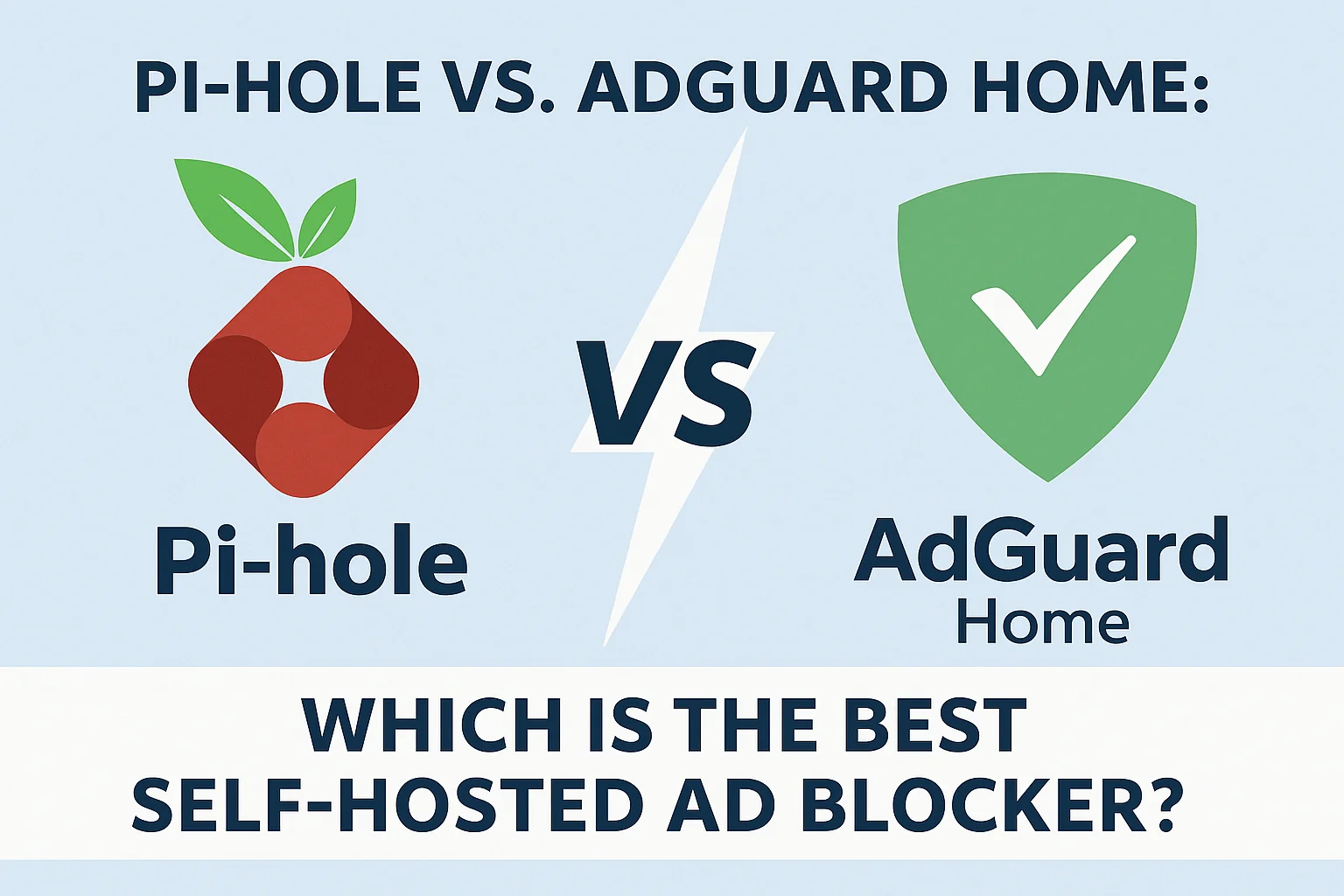Introduction
When it comes to taking back control over your network privacy, blocking ads, trackers, and telemetry at the DNS level is one of the most powerful things a self-hoster can do. Two open-source giants dominate this space: Pi-hole and AdGuard Home.
In this guide, we compare them side-by-side to help both beginners and experienced users decide which DNS-level blocker best fits their needs.
1. Core Concept & Purpose
| Feature | Pi-hole | AdGuard Home |
|---|---|---|
| First Release | 2015 | 2018 |
| Focus | Lightweight DNS sinkhole | All-in-one DNS + parental control |
| Hosting Model | Self-hosted, headless | Self-hosted, includes built-in UI |
| DNS Blocking | Yes (blocklists) | Yes (blocklists + filters) |
Summary: Pi-hole started the revolution, but AdGuard Home built on that foundation with an integrated UI and broader feature set.
2. Installation & Setup
| Aspect | Pi-hole | AdGuard Home |
| Setup Method | Bash script / Docker / Proxmox LXC | Single binary / Docker / LXC |
| Initial Setup | Terminal-based wizard | Web GUI-based setup |
| Resource Usage | Very low | Slightly higher, still lightweight |
| Beginner Friendly | Requires terminal use | Web installer makes it easier |
Beginner Tip: Both tools are easy to install on a Raspberry Pi or mini server, but AdGuard Home is more GUI-centric out of the box.
3. Web Interface & UX
| Feature | Pi-hole | AdGuard Home |
| Admin Dashboard | Clean, minimal | Modern, feature-rich |
| Query Logs | Yes | Yes (more detailed) |
| Device Stats | Yes (basic) | Yes (per-device stats, UI rich) |
| Themes/Customization | Limited | Light/dark modes |
Observation: AdGuard Home’s interface is more refined and user-friendly, particularly for managing devices and filtering.
4. Filtering Capabilities
| Feature | Pi-hole | AdGuard Home |
| Blocklists | Yes (community lists, custom) | Yes (blocklists + DNS filters) |
| HTTPS Filtering | No | Limited (only via DoH proxy) |
| Parental Controls | No (manual lists only) | Yes (categories like adult, social) |
| SafeSearch | Manual setup | Built-in toggle |
Advanced Users: AdGuard Home offers more granular filtering and features like SafeSearch toggles that Pi-hole lacks.
5. DNS & Network Features
| Feature | Pi-hole | AdGuard Home |
| Upstream DNS Support | Yes | Yes |
| DoH/DoT Support | Indirect (via Unbound) | Native support |
| Conditional Forwarding | Yes | Yes |
| DHCP Server | Yes (basic) | Yes (more advanced) |
Insight: If you’re planning to use encrypted DNS protocols like DNS-over-HTTPS (DoH) or DNS-over-TLS (DoT), AdGuard Home is the more turnkey solution.
6. Security & Privacy
| Aspect | Pi-hole | AdGuard Home |
| Telemetry | None | Minimal (can be disabled) |
| Logs Retention | Configurable | Configurable |
| DNS Encryption | Via 3rd-party (Unbound/Stubby) | Built-in |
| Authentication | Basic (password) | Password + optional access controls |
Privacy Verdict: Both are privacy-respecting, but AdGuard Home gives more out-of-the-box features for encrypted DNS and UI access control.
7. Community & Extensibility
| Feature | Pi-hole | AdGuard Home |
| Plugin Support | None | None (monolithic app) |
| Active Community | Very large | Growing rapidly |
| Docs & Wiki | Mature, well-documented | Good, still maturing |
| Custom Scripting | Bash / Cron | Less accessible |
Note: Pi-hole has been around longer and has more community-driven tutorials and scripts available.
8. Use Cases & Best Fit
| Use Case | Best Fit |
| Lightweight, reliable ad blocking | Pi-hole |
| Family control and device filtering | AdGuard Home |
| Integration with Unbound or VPNs | Pi-hole |
| Beginner-friendly DNS filtering dashboard | AdGuard Home |
9. Final Verdict
Choose Pi-hole if:
- You want a battle-tested DNS ad blocker with a strong community.
- You prefer simple, transparent tools.
- You’re okay setting up extras (e.g., Unbound, DNS-over-HTTPS).
Choose AdGuard Home if:
- You want an all-in-one DNS filtering solution with DoH/DoT and parental controls.
- You’re setting this up for a household or less technical users.
- You prefer GUI-based management and smart filtering.
Example Setup
- Pi-hole + Unbound + WireGuard VPN for private DNS anywhere.
- AdGuard Home on Raspberry Pi 4 serving as home DHCP/DNS server with device-level stats and parental controls.

